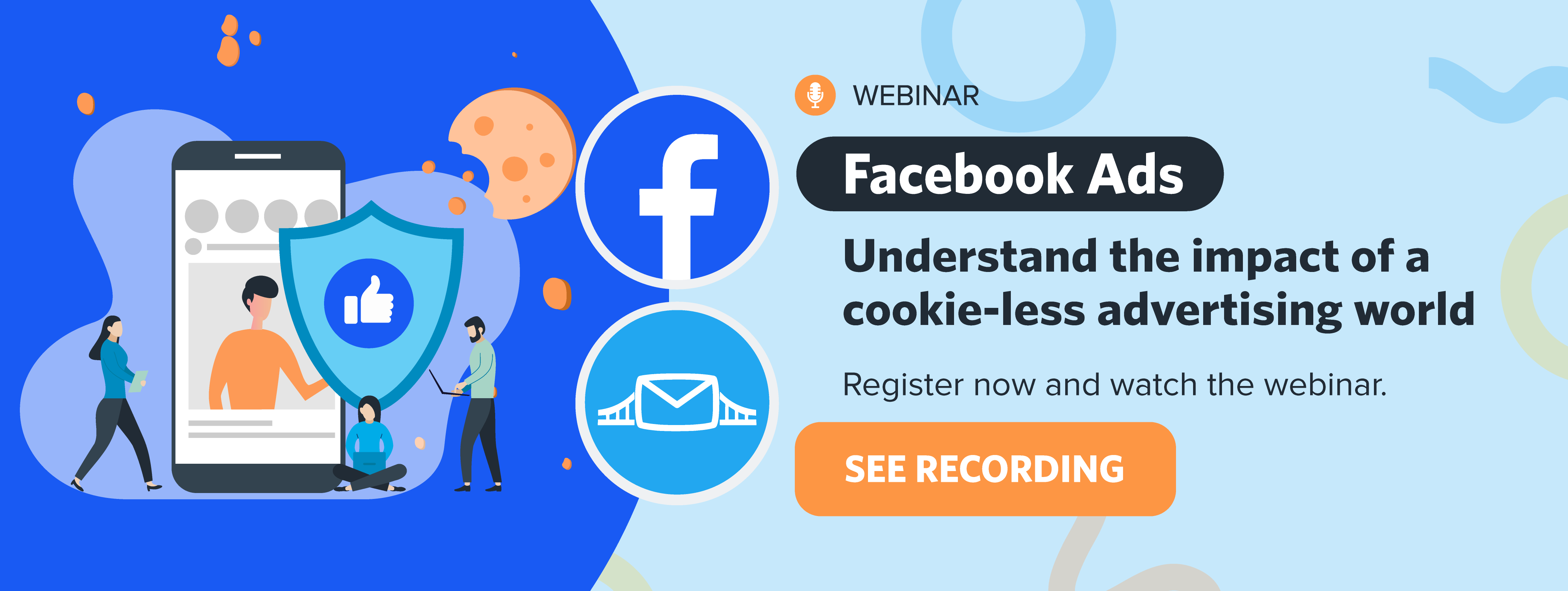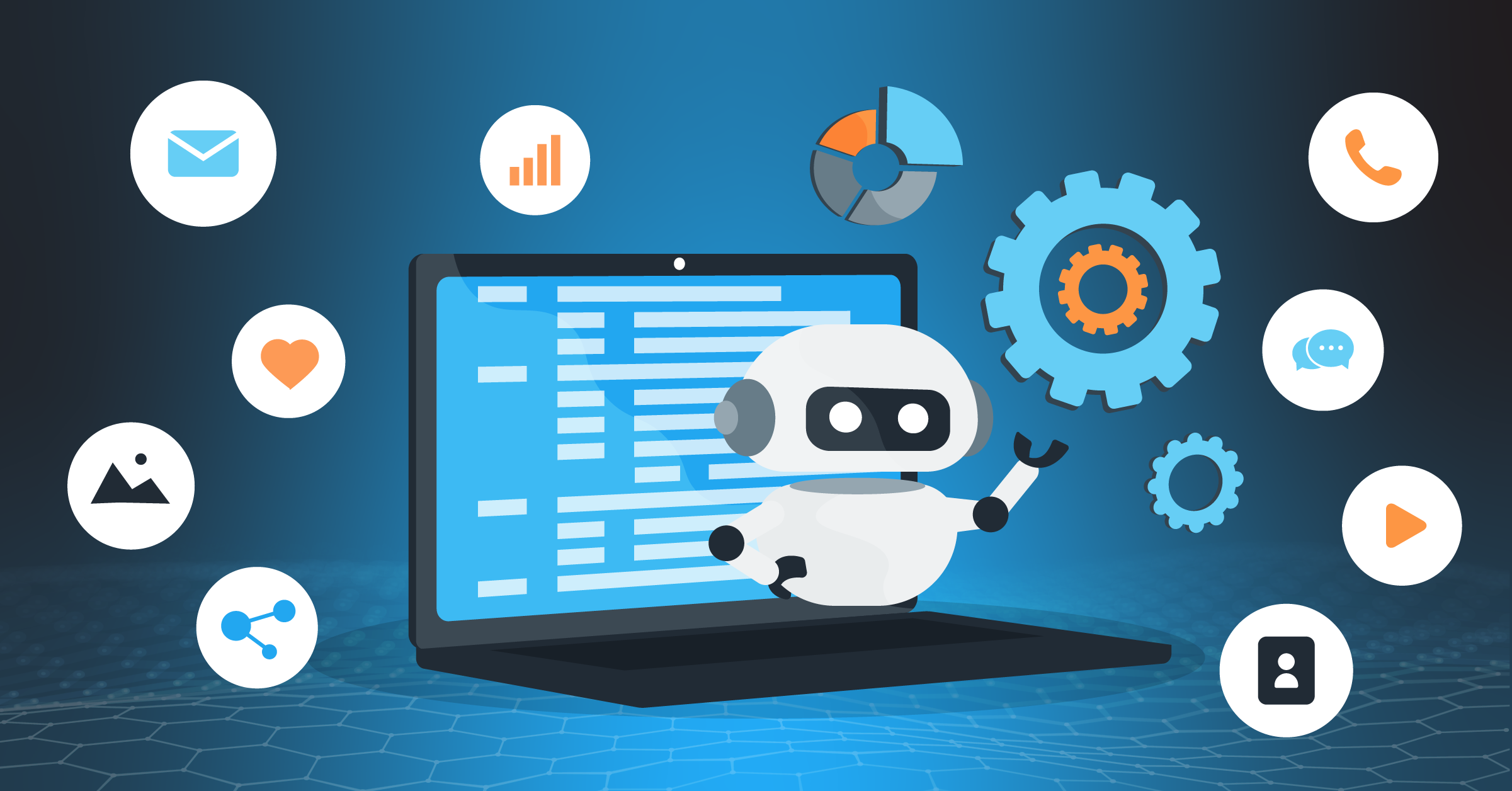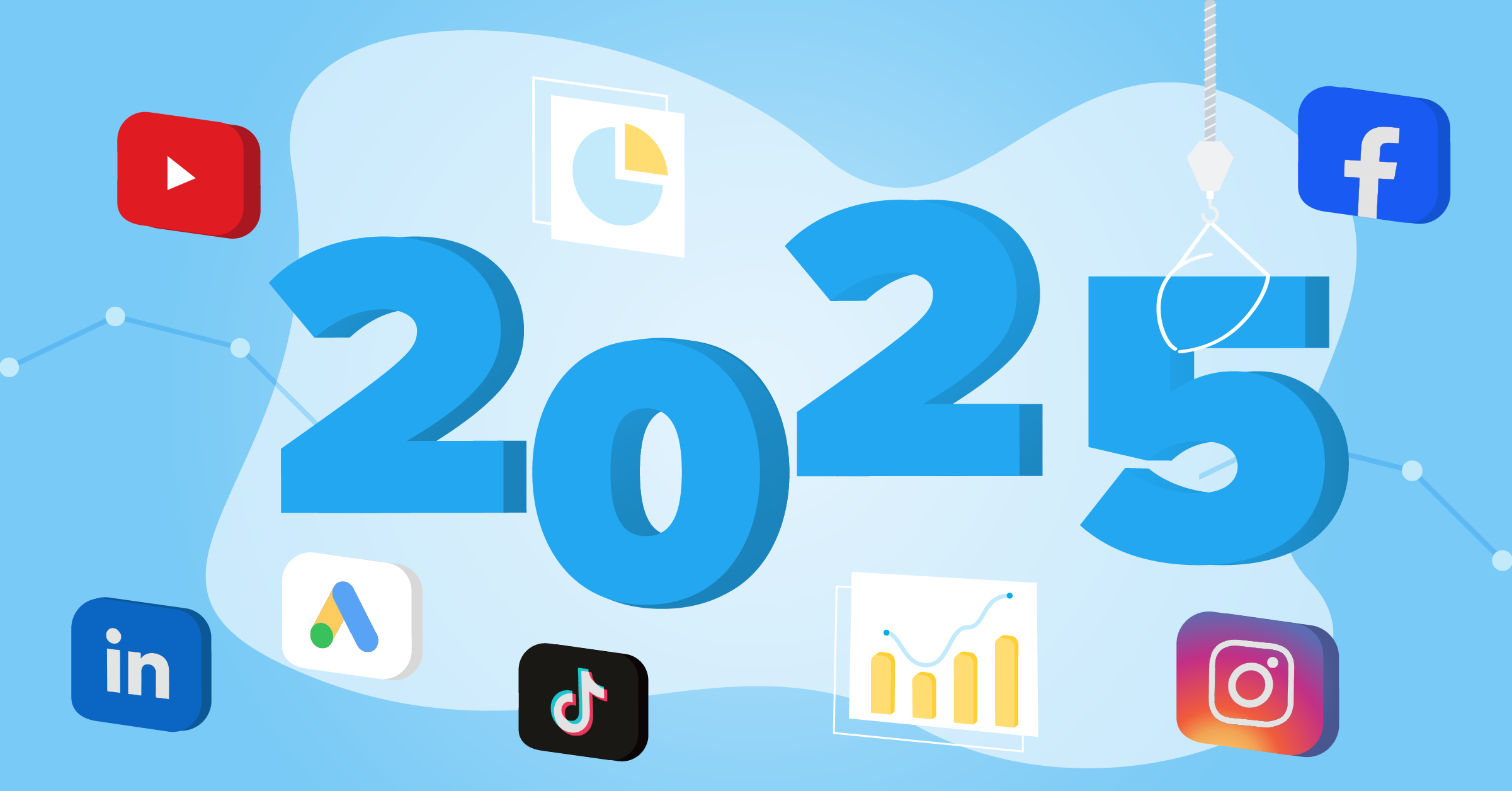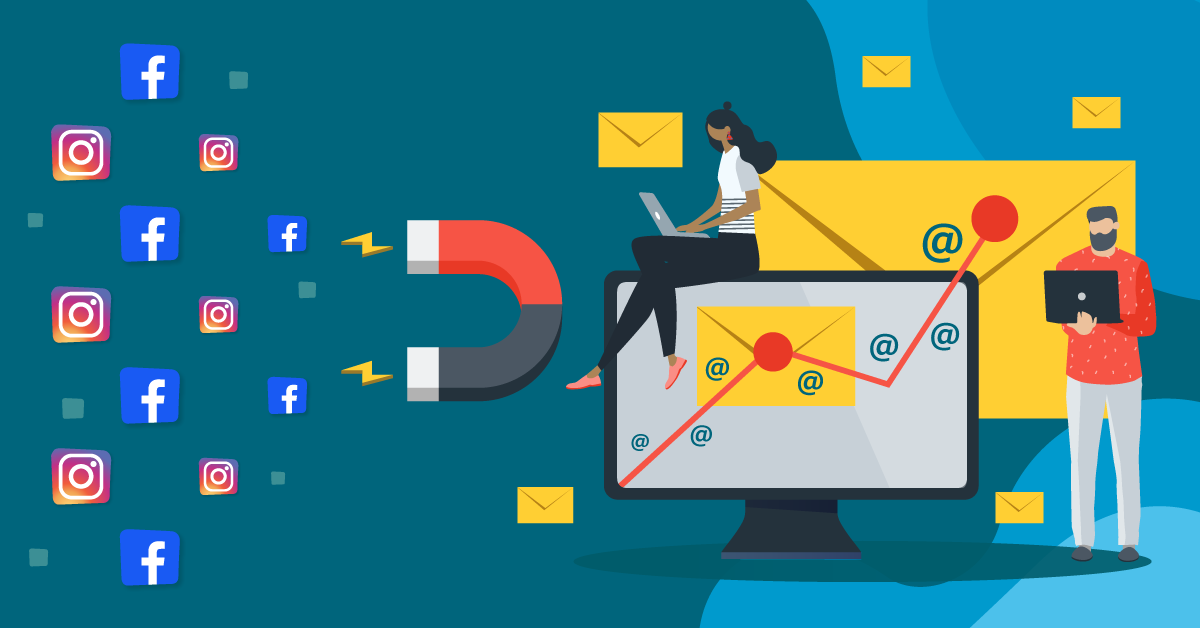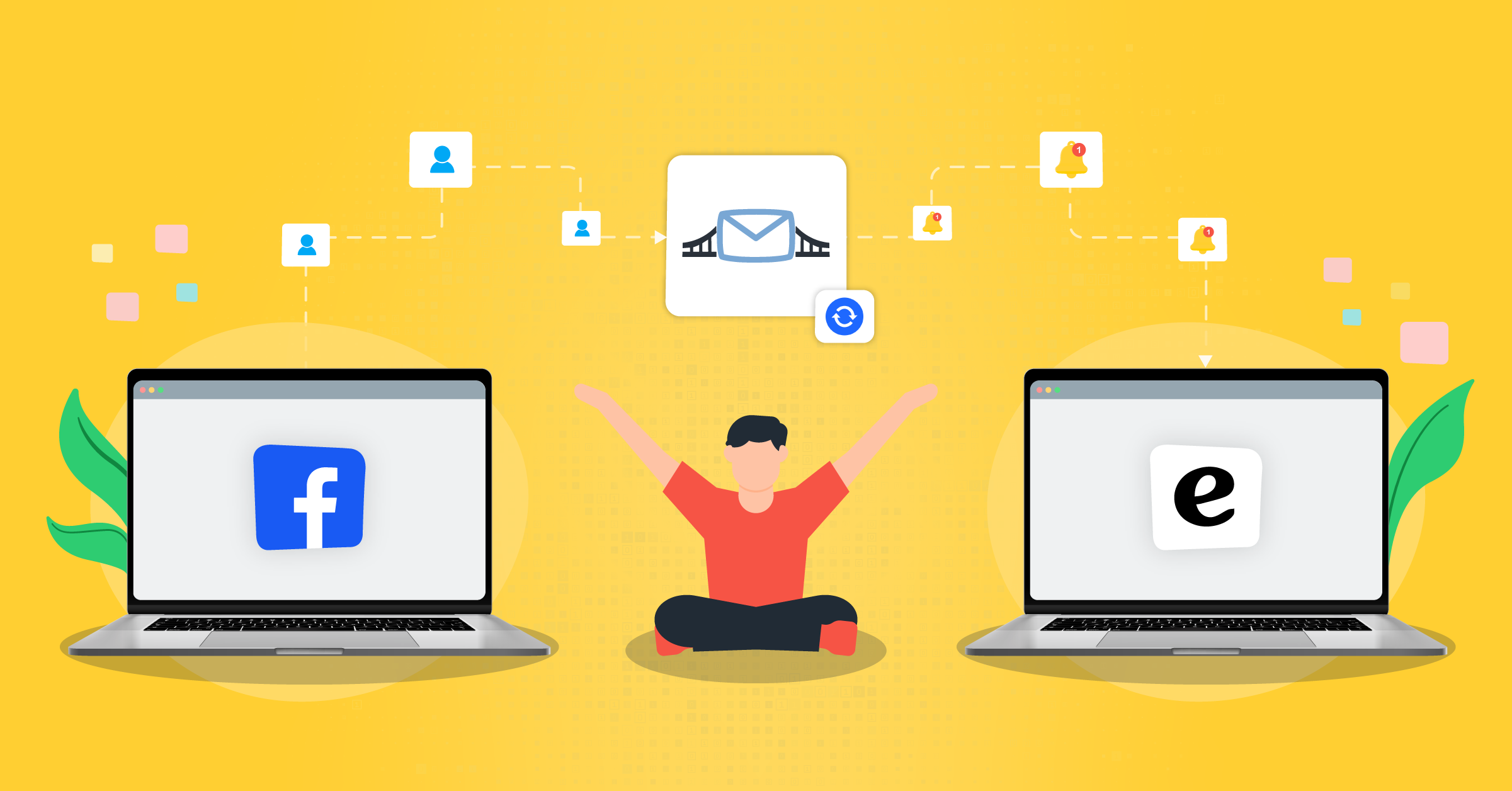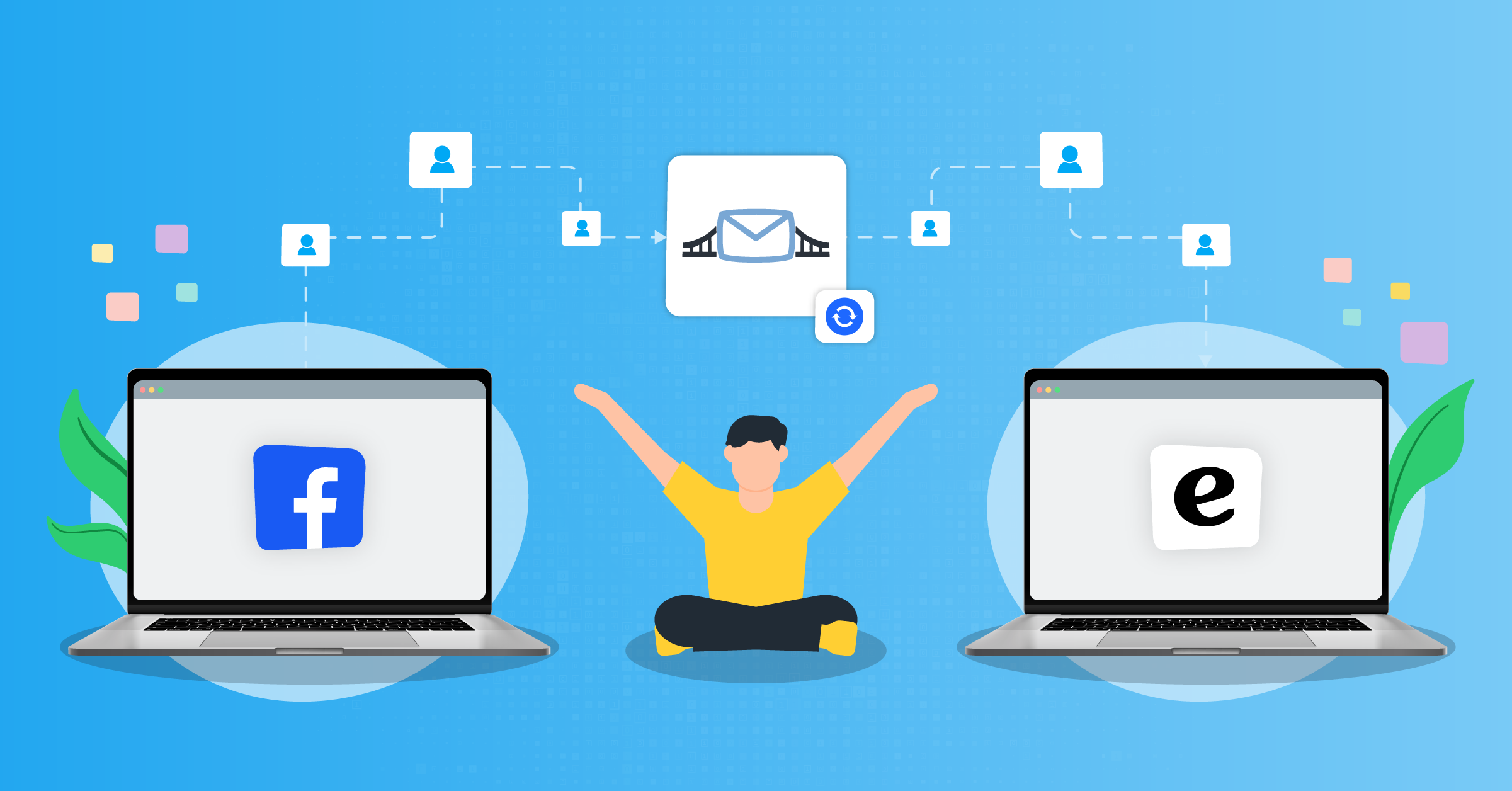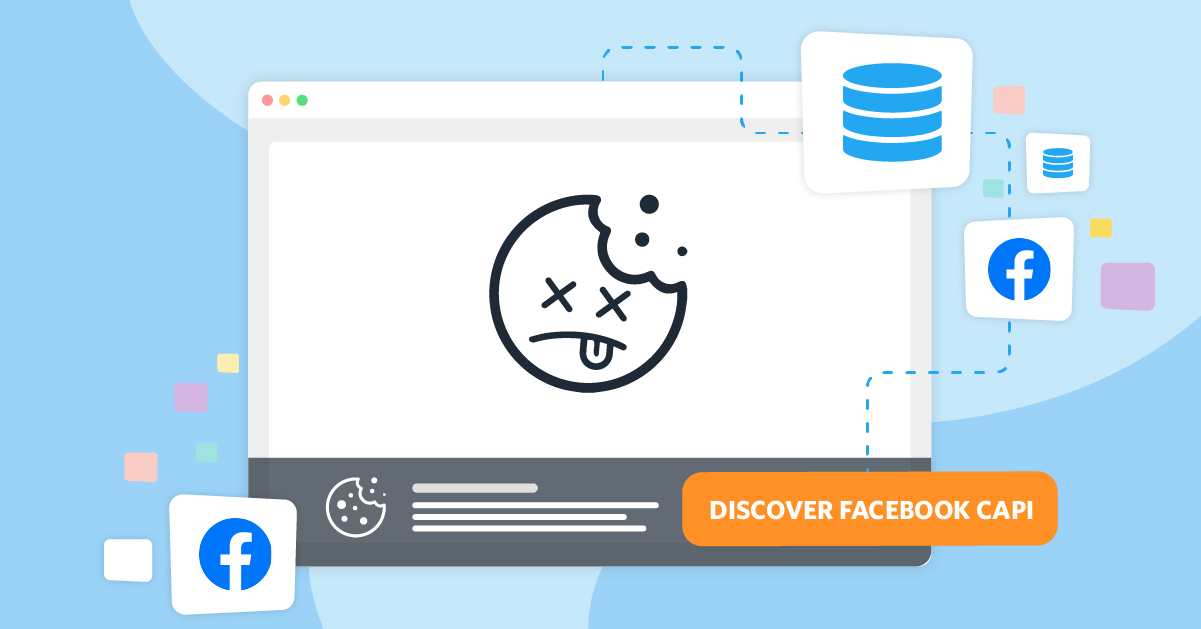
Advertising is substantially reliant on data. What goes in terms of current trends, target audience behavior and expectation, and even tone of voice used to communicate the message.
All turned into traceable bits of information. In digital advertising, this data comes from browsers.
That brings us to new privacy regulations. These measures have forced marketers to adapt to cookieless tracking and reshape the way they approach data acquisition and strategizing.
- What is Facebook Conversions API?
- How does Facebook Conversions API work?
- Facebook Conversion API – iOS 14
- Facebook Conversions API vs. Facebook Pixel
- Benefits of Facebook CAPI
- Benefits of integrating Facebook Conversions API with your CRM
- Why use LeadsBridge as a Meta Business Partner
- Facebook API-CRM integrations
- How to connect your data with Facebook Conversions API
- How does LeadsBridge help with Facebook Conversions API?
- How to set up Facebook Conversions API integration through LeadsBridge
- Key takeaways
But if third-party cookies are no longer the cornerstone of online advertising, what will change? And how do we stop privacy implications from blocking data collection with cookies and Pixels?
In this article, you’ll discover how Facebook Conversions API can help businesses overcome data collection modifications. Also we’ll cover tools and integrations that can be used in conjunction with this.
What is Facebook Conversions API?
Facebook Conversions API (formerly Facebook CAPI) is designed to help businesses deliver personalized advertising experiences to their audiences. This, of course, all while maintaining data privacy.
This tool allows you to send web events from their respective servers, directly to Meta. The entire process is achieved without a reliance on browser-based tools, including cookies.
Facebook cookieless tracking
Taking third-party cookies out of the equation is actually good. For users who get more data protection and for businesses who can show they uphold data handling ethics.
However, this also has posed a great challenge. Brands can no longer rely on cookies to optimize their strategies for effectively targeting users whilst simultaneously measuring campaign performance.
In the past, you could track Facebook ad campaigns by inputting some lines of JavaScript code, and have Facebook Pixel do the rest. However, this is not the case anymore.
Conversions API provides a solution for Facebook cookieless tracking by allowing for the sharing of data directly from your business’ server. The data within the API is then transferred directly into Meta where it’s handled similar to pixel events.
Once completed, you can monitor the conversions that take place and make adjustments wherever necessary within the Meta Ads Manager. You can do this by fully upholding the user’s specific privacy preferences.
Facebook Conversions API and data privacy
With the development of Intelligent Ad Tracking Prevention (ITP) systems, browsers started to move away from third-party data entirely. That shift pushed marketers to be more mindful of how they collect and use data.
These days, things have changed slightly. In the EU, any data handling means having clear consent and being upfront about how info is used. In the U.S., laws like the CCPA require similar transparency, giving people the option to opt out of data sharing.
Instead of sharing data with the browser, companies cut through all these complexities by using Conversions API to share the data that matters with Meta through their server.
This is a more privacy-friendly way to track performance and reach the right audience without relying on third-party cookies.
It means that if a customer uses a privacy tool for non-Facebook activity, their actions will be extended to data sent through Conversions API.
So, where does the end-user opt in to get recorded?
The user opt-in is recorded on your website. That consent is then passed to Facebook when uploading conversion activity via Meta Conversions API. If the user opts out, a new event is fired with this information – consequently removing it from the audience.
Additionally, there are major differences between how cookies collect data vs. how the API collects data. What cookie-based data has the ability to collect is strictly dependent on end-user browser preferences. This is particularly important for what concerns ad-blocking extensions.
Facebook Conversions API (formerly Facebook CAPI) sends server events instead, bypassing these limitations. This Blueprint training can be used as a resource for more information.
Server-side API Facebook
Server-side APIs are programmatic interfaces that contain at least one publicly open endpoint to a request/response system. Mostly, these are expressed in JSON (JavaScript Object Notation) or XML (Extensible Markup Language).
These are exposed through the web, usually through an HTTP web server. As previously mentioned, the Server-side API from Facebook is no longer known as such. Instead, it is now referred to as Conversions API.
Conversions API Facebook
Facebook itself encourages advertisers across the board to implement Conversions API in addition to Pixel for optimal full-funnel tracking and reliable data sharing. This way, advertisers can transmit a larger array of data in order to back their advertising efforts.
With the implementation of Conversions API, data such as CRM data and lower funnel events can be captured. This is more than Pixel can offer alone. Moreover, companies with high-security needs can use this to decide which data they wish to share.
Setting up Conversions API will require some development resourcing. However, a network of Facebook-certified partners or your own existing system integrator/marketing platform provider automate the process.
How does Facebook Conversions API work?
Although this may seem like an overwhelmingly technical process, it’s quite simple when broken down into sections.
Here is a quick rundown of how Facebook Conversions API works:
- The customer enters the website.
- The website must have a Meta Pixel. Meta Pixel documents first-party user data in cookies.
- The server will save user information in the same way that it saves IP addresses, user agents, Google Analytics client_id, and other parameters.
- When the user (with their saved user data) triggers an event, the server will make a request that contains information about the said event and said user data to the Facebook server.
To activate the Facebook Conversions API feature, you will need to set up the following:
- Meta Business Manager (this is a must, since you cannot use Meta Conversions API without it);
- A Meta Pixel with your website. It’s important to note that it should be correlated with the Business Manager;
- The specialized Meta App. This is an app for working with Facebook Conversions API, and it’s combined with Business Manager.
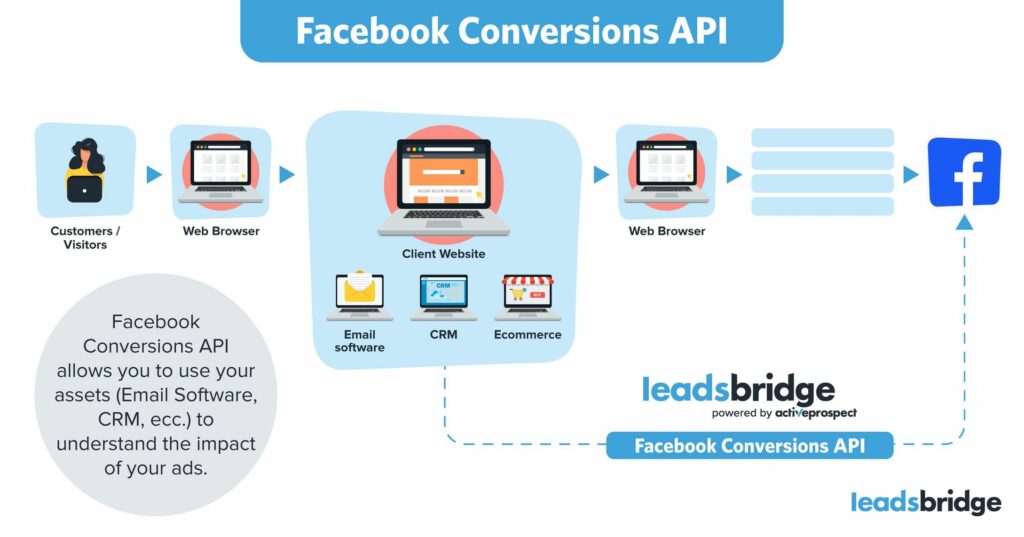
What data is passed to Facebook with Conversions API?
When you use the Conversions API, various types of data can be sent back to Meta. This includes actions that users take on your website, like purchases, form submissions, product views, and other interactions. It can also send data from your app, such as in-app purchases or user registrations.
Additionally, the API can pass information from offline interactions like in-store purchases or phone calls and data from your CRM. This could be your customer email lists or past transactions.
All of this data helps Meta understand and track user behavior better. The platform then uses this data to optimize ad performance, create more accurate custom audiences, and give you detailed reports on how your campaigns are performing.
What conversions can be tracked with Conversions API?
With all this talk of event tracking, it’s important to note which events are tracked through Facebook CAPI.
These events are as follows;
- Leads
- Affiliate payments
- Find locations
- Phone calls
- Form submissions
- Purchases
- Email subscriptions
- Subscription changes
Facebook Conversions API has a unique set of benefits that the browser Pixel does not possess. This also includes a better overview of omnichannel customer journeys.
The result is overcoming event tracking obstacles, such as:
- Bad network connections
- Long loading times for pages
- Ad blockers
Possibly, the most significant benefit of Facebook Conversions API is offering data control over what’s shared with Facebook servers. This gives you the ability to track offline conversions like in-person purchases and sales made over phone calls.
With Conversions API, you can also send offline events’ data directly to Facebook.
What is the Conversion leads performance goal on Facebook?
The Conversion leads performance goal is a new feature for Facebook lead ads. Once set up, it basically helps you prioritize users who can be converted to high-quality leads easily.
While Facebook lead ads prioritize the volume of leads, the Conversion leads performance goal focuses on the quality of your leads. So to display your ads to higher-quality potential leads, Meta gathers your existing customers’ data and creates audience segments.
LeadsBridge lets you connect your CRM or other data storage tool you might have with Facebook Conversion leads performance goal:
How to check Conversions API for Facebook events: A step by step guide
Without proper verification during your Conversions API setup, you risk missing key events, sending outdated data, duplicating events, or failing to match them to the right users. This can well result in wasted ad spend, poor data enrichment in your CRM, and reduced results. The good news is that you can look for and fix these issues.
Here’s a step by step guide that help you do just that:
Step 1: Make sure events are received as they are.
After you set up the Conversions API, you want to confirm that Facebook is getting the information (events) you’re sending. This could be anything important to your campaign, such as clicks, purchases or sign-ups.
How to check for them?
- Go to Facebook Events Manager.
- Find your Pixel (it’s linked to your website).
- Look for the events you sent. You should see them within 20 minutes of sending.
Step 2: Check that events are sent fast and potentially in real-time.
It’s important that events are sent to Facebook as soon as they happen to keep your ads effective.
To make sure your events are recorded as they happen, you’ll need to take a look at your data source. Here’s how:
- In Events Manager, go to the Data Sources page.
- Click on your Pixel.
- Click on Overview.
- Here, you can see how fast your events are being received. Look for the Event Freshness section to see if events are coming in real-time or with some delay.
Step 3: Check for duplicated events. (You don’t want any!)
If you’re using both the Meta Pixel and Conversions API, you need to make sure the same event isn’t counted twice.
How to double check for this data?
- In the Events Manager, go to your Pixel’s Overview.
- Click on Event Details for a specific event type.
- Go to the Event Deduplication tab.
- Check the Rate of Events Deduplicated. A higher percentage means fewer duplicates, which is better.
Step 4: Check that Events are linked to the right users.
This helps Facebook match the events to the right people, improving your ad targeting and performance. Here’s how to check for it:
- In the Events Manager, find your Pixel and go to the Overview page.
- Look for the Event Match Quality score. It ranges from 1 to 10.
- Aim for a score of 6 or higher. This means Facebook is doing a good job matching events to user accounts.
- Click on the Event Match Quality score to see tips on how to improve it if needed.
Step 5: Continue monitoring your campaign’s events.
Keep an eye on your events to see if everything stays in good shape. To do this, you need to:
- Regularly visit the Events Manager.
- Check the Overview and Event Details to see how your events are performing.
- Look for any warnings or issues that need fixing.
3 Facebook Conversions API examples
The Conversions API creates a direct and dependable link between all your company’s marketing data and Meta. What this connection does is fortify your ad targeting and optimization by a long shot.
Data-driven advertising efforts can be online, app, and offline conversion events. You eventually gather enough data to be able to run personalized campaigns and optimize your audience targeting for higher conversion rates.
Let’s take a look at some of the Facebook Conversion API examples.
SumUP’s Facebook Conversions API use case
SumUp, a European financial technology startup, increased quality leads by 10% via a conversion-optimized ad campaign that integrated Facebook’s Conversions API with its CRM system.
Unlike your usual lead volume optimization, this technique highlights producing higher-quality leads using offline conversion data.

SumUp increased its targeting accuracy by securely submitting offline conversion-related actions to Facebook’s server via the Conversions API.
The result was a remarkable 10% increase in qualified leads, a 15% drop in cost per qualified lead, and a 12% rise in addressable leads.
Fever as a Facebook Conversions API example
Fever is a worldwide entertainment discovery network. By running advertisements across different Meta applications, the company used the Conversions API and custom conversions.
These tools eventually positively affected their return on ad spend, which was around 2.1 times higher.

Fever achieved these results by optimizing for specific client behaviors. And more profit was not the only game. It also improved their understanding of the customer journey via the insights they gained through Conversions API.
All these improvements brought about a 2.8X decrease in cost per purchase, a 2.4X rise in view content, and a 2.4X decrease in cost per view content.
YOOX NET-A-PORTER & Facebook Conversions API case study
An international online fashion and lifestyle destination, YOOX NET-A-PORTER, boosted its Facebook ad sales (30%) by simply integrating the Meta Pixel and Conversions API. Well, there’s more to it actually:

Meta Pixel provided insights into their users’ behavior. This is while the Conversions API enabled the direct sharing of key web and offline events from YOOX’s server to Meta. This integration improved their ad targeting, cost reduction, and accuracy of tracking efforts.
To put this in a quantifiable perspective, the company witnessed a 30% boost in purchases, a 25% reduction in the cost per purchase, and a 30% increase in return on ad spend just during the test period.
Facebook Conversion API – iOS 14
Apple implemented its new App Tracking Transparency framework in iOS 14 back in 2020. This implies that app developers must let users know that their data is being collected. They must request permission from users to track how they engage with apps.
Advertising and marketing as we know them are changing, mostly due to the GDPR’s data privacy laws and regulations.
This means if users opt out of tracking, their behavior cannot be tracked again. The iOS 14 changes impact all apps, which is why Facebook encourages marketers to switch to server-side tracking.
The impact of this change includes:
- Inability to track iOS users after they opt out; you cannot use retargeting campaigns for them.
- Events are limited to 8 per website; you cannot use custom events.
- Unverified domains are unable to use events; you cannot optimize your campaigns for outside events.
- Facebook no longer supports the attribution windows of 28-day click-through, 28-day view-through, and 7-day view-through attribution windows. This makes it difficult to analyze campaigns.
- There will be no real-time reporting anymore. Data will experience delays.
How to tackle iOS 14 changes
- Use Facebook Conversions API (or Facebook CAPI) to track conversions, optimize campaigns, and create custom audiences. Instead of using the browser pixel, events are sent through the server.
- Verify your domain.
- Use aggregated event measurement tools to choose the eight events available for a website.
Facebook Conversions API GDPR
Facebook Conversions API has presented itself as an alternative to previous tools that have been subject to extensive data regulations. However, it must still abide by general data protection regulations.
The API is independent of the use of third-party cookies, which means it fully complies with GDPR regulations. Additionally, Facebook Conversions API’s GDPR compliance is maintained by offering increased data control with more nuanced sharing and tracking settings.
In fact, many businesses using Facebook Conversions API can better comply with GDPR specifications by appending their insights within Facebook.
Conversions tracking & iOS updates in 2025
The trend continues with Apple and the EU tightening their privacy rules. Apple’s latest update in iOS 18.4 gives users in the EU more control, like choosing their own default navigation apps.
Adding that to Apple’s App Tracking Transparency (ATT), we’ve got a lot more people opting out of tracking. That means browser-based tracking tools (like Meta Pixel) are more limited.
On top of that, Apple now requires apps in the EU to prove they’re legit businesses (called “trader status”) or they’ll be removed from the App Store (effective February 17, 2025). It’s all about giving users more privacy and control.
That’s where the Meta Conversions API comes in. Instead of relying on cookies or the browser, it sends data straight from your server to Meta. This helps:
- Track conversions more accurately (even when people opt out of tracking)
- Improve ad targeting and performance
- Give you control over what data is shared, which helps with GDPR compliance
If you want to keep your marketing running smoothly and stay on the right side of privacy laws, tracking through Meta Conversions API is now (and more than ever) a way out.
Facebook Conversions API vs. Facebook Pixel
Conversions API helps businesses share specific online and offline events between their server and Facebook’s Server.
Facebook Pixel has been around for quite a while now. It essentially helps businesses track the effectiveness of their product or service. This piece of code tracks what people do on your website, including the pages they visit, what actions they take on those pages, etc.
Conversions API vs. Facebook Pixel: What are the differences?
The Facebook Pixel and Conversions API tools are fundamentally different in how they work. Yet, they are combined as a unit to improve marketing performance on Facebook.
Let’s have a look at the major differences between the two tools below:
Facebook Conversions API makes up for the ad tracking obstacles. It essentially solves problems such as lengthy load duration, inadequate network connections, and ad blockers.
Unlike Pixel, Conversions API does not show the customer’s complete journey and presents only the end result. However, it helps measure customer actions using the Facebook pixel to gain visibility into your buyer’s entire journey.
Facebook Conversions API helps you control the data you share and when you share it. In addition, it offers accurate information you can use for ad targeting, measurement, and optimization (if used with Facebook pixel).
On the other hand, Facebook Pixel gathers important data for creating optimized Facebook ads and audience targeting. It also helps you track your customers’ interaction with your products or specific conversion events across your business page.
Weighing your options to know which is the best for your business? The answer is using the Conversions API in addition to Facebook Pixel since both tools are very consistent and extremely effective if used as a unit.
Benefits of Facebook CAPI
Facebook Conversions API can let you share data directly from your server to Facebook. Sharing data like this allows you to achieve the following;
- Accurately measuring actions in multiple ways. It lets you share events like delayed values and user/lead scores so that you can use them for further optimization with other Facebook tools.
- Improving targeting data accuracy with measurements and optimizations when paired with Pixel.
- Gaining complete control over the data you share and when you share it
This is all possible as server events are linked to your pixel and behave like browser events. This is how they do it:
- They’re used for the same ad optimization, including conversion and value.
- They appear on almost all of the same surfaces. Two of which include Ads Manager and Events Manager.
- They abide by the same controls and restrictions implemented by Facebook, like with the Off-Facebook Activity tool and the Facebook Business Tool Terms.
Using API to send conversion information goes around the IOS restrictions. When Facebook Conversions API is purely used to track offline activity with lower-funnel events (e.g., Purchase), iOS 14 restrictions will not be taken into consideration as such activity doesn’t come from any specific OS.
Remember that with the iOS 14 update apps in the App Store need to ask for specific permission before using customer data. This takes the form of an in-app prompt that details how the data is being used, and gives the user explicit permission to opt out if they want to.
How Facebook CAPI advertising can help to improve your campaigns
The Conversions API essentially creates a direct and reliable link between your business’s marketing data and Facebook. This feature enhances your advertising targeting and optimization.
It collects event data from your website, apps, and offline conversions. All this collective information enables you to run personalized campaigns, laser-sharp audience targeting, and achieve better conversion rates.
With Facebook Conversions API, you do more like tracking a higher number of conversions and gaining deeper insights into Facebook campaign performance. And when you combine Facebook Conversions API and Pixel capabilities, you’ll get a comprehensive view of the customer journey.
This is the holy grail of every advertiser: simplifying strategy planning through advertising actions that are based on data.
What most businesses don’t realize about the importance of Facebook Conversion API
We have covered cookieless tracking and compliance with user data privacy regulations. But there are some topics we haven’t talked about.
Here are some facts every business that runs ads on Meta should know about the importance of Facebook Conversions API.
1. It fills in the gaps pixel misses
When a user clicks your ad, but their session is disrupted (private mode, poor connection, or ad blockers), the Facebook Pixel could easily fail to track the conversion.
Meta’s Conversion API however can capture these missed events directly from your server. This saves you from losing credit for sales that actually happened.
2. It’s perfect for subscription businesses
Do you offer subscription-based services or offers? Your Facebook Pixel can’t track billing events like upgrades, cancellations, or renewals.
But with Facebook Conversion API, you can send these key actions straight to Meta to track long-term customer behavior.
3. It tracks users across devices
Customers often discover your brand on one device and convert on another. The Facebook Conversion API helps you follow these cross-device journeys much more accurately. This process relies on unique identifiers passed through the server, which again is something the browser Pixel cannot do alone.
4. Event order and prioritization are in your hands
Do you use Aggregated Event Measurement? You already know how important the order of your events is. The Conversion API lets you control and customize event priority and structure, so you’re not stuck with whatever data the browser captures.
5. Higher match rates for even better retargeting
Passing data like hashed emails or phone numbers through the Facebook Conversion API is a huge advantage for Meta, well, your campaigns. The platform can use this data to better match users to their accounts.
That naturally means stronger custom audiences, more accurate lookalikes, and higher-quality retargeting.
6. It acts as a safety net
If the Facebook Pixel fails to fire (due to a slow load, bad connection, or an ad blocker), the Conversion API is your backup. It ensures you don’t lose valuable conversion data that impacts optimization and reporting.
7. It feeds Meta’s Machine Learning Engine
The more accurate data you feed Meta, the better their ad algorithm performs. This is especially important for lower-funnel events. The Conversion API provides server-verified data, which supports your campaigns’ optimization for real results (even with limited visibility).
Benefits of integrating Facebook Conversions API with your CRM
Connecting Conversions API with your data management system is a robust solution. It bridges the gap between online interactions and offline conversions.
This way, you can better understand the customer journey from online engagement to offline actions (such as in-store purchases, bookings, or consultations). And this knowledge is a must if you want to build your marketing strategies in a way that leads to higher ROIs.
Here are the key benefits of this integration:
- Having better conversion tracking accuracy
On one side, there are the restrictions on third-party cookies, and the growing use of ad blockers from the other. This is to say, tracking conversions through traditional methods is not just reliable any longer. It can even be a legal risk.
Facebook Conversions API provides a server-to-server connection. This means your tracking doesn’t rely on browser cookies, while being a more stable and accurate way to track user actions.
Facebook Conversions API for CRM integration also syncs offline conversion events (like in-store purchases) back to Facebook. This gives you a holistic view of how online advertising efforts are contributing to offline sales.
- Offering personalization and precise targeting
Merging Facebook’s massive user data with the detailed customer data in your CRM (like offline interactions) equals data-based marketing strategies that work.
You can use this enriched data set to create more precise audience segmentation in your CRM. Or, use your detailed conversion data from your CRM to create highly targeted custom audiences on Facebook.
- Optimizing your Ad Spend
Having a more accurate conversion tracking allows you to understand which ads are driving real-world outcomes. So you can allocate your advertising budget where it matters and increase overall return on investment.
- Getting ample marketing insights
Another one of Facebook Conversion API benefits with online interaction data allows businesses to gain a complete view of the customer journey. This can uncover insights into which digital touchpoints are most influential in driving offline actions.
- Establishing better compliance and data privacy practices
Since Facebook Conversions API operates through direct server-to-server communication, it can be configured to just share hashed, anonymized data with Facebook. This helps you and your team stay in tune with privacy regulations while building better customer trust.
Why use LeadsBridge as a Meta Business Partner
Many companies have the option to develop Facebook Conversions API technology in-house. But with so many operational duties already existing, is that the best solution available?
Undoubtedly, the answer is No.
There are several things that companies need to address in order to get the most out of this technology, including:
- Having a deep understanding of Facebook Conversions API
- Quickly developing the necessary integrations and keeping them up to date
- Properly managing complex data whilst avoiding leaks
So, how can companies use this technology without encountering the problems listed above? Simple, they need to use an FMP like LeadsBridge.
Here are the highlights:
Exclusive access to up-to-date APIs
LeadsBridge is a Meta Business Partner, and a great integration provider for easy API management and maintenance.
By using our platform for Facebook Conversions API technology, you’ll always have up-to-date and functional integrations. Facebook usually updates its APIs every two or three months.
Troubleshooting technical issues for you
Like all data partners, LeadsBridge can troubleshoot technical issues for the server-to-server program along with the length of service.
And if your team needs to update the integration and add more data, our Solution Specialist will guide you using our UI or talk to your tech team to understand how we can retrieve more data.
Access to services ranging from free to tailor-made solutions
Our tailor-made integrations are built to match your company’s exact requirements while allowing to decrease the “time-to-market significantly”.
Once integrated with LeadsBridge, you will be able to send your data to any other platform, e.g., Facebook, Google, or Business Intelligence (BI tools).
Facebook API-CRM integrations
In order to get the most out of Facebook Conversions API (or CAPI), you’re going to want to integrate it with your favorite CRM. LeadsBridge offers pre-built Facebook API-CRM integrations to help you set up in just a few clicks.
What’s more, you can also get tailor-made integrations to meet your exact advertising needs and any in-house-built systems you might have.
Facebook Conversions API + Salesforce® integration
The Facebook Conversions API and Salesforce® connection is one of our most popular data bridges.
Connecting Facebook Conversion API with Salesforce® allows you to send new Salesforce® records. Then, the data is sent to Facebook Conversions as lead events and also creates new leads.
Salesforce® is a Customer Relationship Management (CRM) application for small, medium, and large businesses. It enables businesses to track communications and connect with their customers, employees, partners, and products.
Integrating the two platforms facilitates automated lead data sharing in real-time. Although Facebook does have data about its users, your Salesforce® CRM contains all your customer’s details – which Facebook might not have. Therefore, you can leverage this information to build better-targeted ads and make more sales.
With the Facebook Conversions API – Salesforce® integration, you can share and sync different types of data, such as CRM data, lower-funnel events, or multi-site conversion paths on a website and offline location.
Learn more about our Salesforce® – Facebook Conversions API integration here.
Facebook CAPI + ClickFunnels integration
Another one of our sales-funnels focused bridges is the integration between Facebook Conversions API and ClickFunnels.
ClickFunnels is a tool for service-based businesses, especially popular amongst fitness coaches and gyms. It’s a drag-and-drop funnel creator and editor that allows even the least tech-savvy creators to build funnels and turn prospects into clients.
This tool lets you create landing pages and sales pages, accept payments, and manage multiple sales funnels with just a few clicks.
Connecting Facebook Conversions API with ClickFunnels streamlines a ton of data management processes.
You can upload to Facebook the exact segments of leads that you want to track and use them as the target of your campaigns. This practice will also help you build more accurate audiences.
HubSpot + Facebook Conversions API
The HubSpot and Facebook Conversions API integration is a favored choice for businesses of all sizes.
HubSpot is a cloud-based CRM platform with several marketing features that help companies deliver an outstanding customer experience, grow their team, manage marketing campaigns, build landing pages, and much more.
By creating the HubSpot and Facebook CAPI integration, you can share your website data and conversion events with Facebook. This data bridge offers better visibility into customer interactions with your brand, allowing you to optimize your ads better.
Unbounce + Facebook Conversions API
A connection that’s gaining more popularity is the Unbounce Facebook Conversions API integration.
Unbounce is a popular landing page builder. while offering other services, it is mainly designed to help marketers create high-converting pages without needing developers.
It’s especially known for its:
- Drag-and-drop interface
- A/B testing features
- Tools built specifically for lead generation
- Performance marketing features
Unbounce lets you build and launch landing pages tailored to specific campaigns in no time. Integrating Unbounce with Facebook Conversions API allows you to send conversion data like form submissions and button clicks directly from your server to Meta.
This connection lets you see how your landing pages perform and optimize your Facebook campaigns with better data. It also helps you build stronger custom audiences based on real user actions.
Shopify + Facebook Conversions API
A connection that cannot be overlooked is that of our Shopify Facebook Conversions API integration.
Shopify is an all-in-one commerce platform that’s mostly designed for independent owners. It offers a streamlined dashboard to manage businesses both online and in-store.
The platform supports sales across various channels, including physical stores, mobile devices, and social media. On its dashboard, you’ve plenty of options to micro-tune every aspect of your business; execute marketing campaigns, manage inventory, process payments, handle shipping, and more.
Integrating Shopify with Facebook Conversions API allows you to track conversions directly from your advertising efforts and re-target users who’ve engaged with your business before.
This connection also lets you monitor orders, specific page visits, cart additions, and checkout initiation. All while providing valuable insights for targeted marketing and traffic analysis.
Join the waiting list for the Shopify Facebook CAPI integration.
How to set up Facebook Conversion API for WooCommerce?
Integrating WooCommerce with Facebook Conversions API can give your ecommerce business the boost you have been looking for.
WooCommerce is a powerful and popular e-commerce plugin for WordPress. It lets website owners transform their WordPress websites into functional online stores.
Users can use it to list products, set prices, manage inventory, process customer orders, and even handle various payment gateways.
Once activated, the Facebook Conversions API – WooCommerce integration automatically links your sales pipeline with WooCommerce orders.
Then, each new WooCommerce order triggers a corresponding Facebook Conversions funnel event. This allows you to measure customer actions and improve event accuracy and data control.
How to connect your data with Facebook Conversions API
It’s easy to see how important Facebook Conversions API is and will continue to be in the marketing world. But how to pass conversion data to Facebook API?
Here are the two ways you can do this!
Facebook Conversion API integration manually
Keep in mind that this process is somewhat complex and requires developer-level knowledge and qualification.
Before you get started
Here’s what you’ll need:
- Pixel ID: If you’ve already set up a Pixel for your website, Facebook suggests using the same Pixel ID for both your browser and server events. If not, here is how to install Facebook Pixel.
- A Business Manager account: If you don’t have a Business Manager yet, use this guide to create one.
- Access Token: To work with the Conversions API, you must obtain an access token, using Events Manager or using your own App (if there is any).
a) The Events Manager method:
- Step 1: Go to the Event Manager on your Business account dashboard.
- Step 2: Choose the Pixel you wish to implement.
- Step 3: Navigate to the Settings tab.
- Step 4: Locate the Conversions API section and click on the “Generate access token” link under “Set up manually.” Then, follow the instructions in the pop-up.
- Step 5: After getting your token, click “Manage” next to Conversions API to auto-create an API app and system user. No App Review or permissions are needed.
Note: The “Generate access token” link is visible only to users with developer privileges for the business and is hidden from other users.
b) The method using your own App:
If you already have your app and system user, you can generate your token within the Business Manager.
- Step 1: Go to your Business’s Settings.
- Step 2: Assign a Pixel to your system user (you can also create a new system user if needed).
- Step 3: Select the assigned system user and click “Generate Token.”
Also, no App Review or permission requests are necessary for your App in this case.
Facebook Conversions API partner integration
When using a partner integration, there are no requirements for coding knowledge; it allows for potential self-implementation without a developer.
This option is available if your website is hosted on a Facebook partner platform, such as WordPress, or if you use a partner customer data platform, commerce platform, adtech, tag manager, or system integrator.
LeadsBridge is one of the Conversion API partner integrations recommended by Meta.
We’ll provide you with access to a team of experts that keep up with anything and everything related to Facebook Conversions API, so you can focus on what’s most important to you: New leads.
Here’s how to set up the conversions API through a partner integration:
Step 1: Go to the Events Manager. Select your pixel from the Data Sources tab and click “Settings” in the top menu.

Step 2: Scroll down to the Conversions API section and click “Choose a Partner” under “Set up through a partner integration.”

Step 3: Find the provider (LeadsBridge) in the pop-up gallery. This will guide you through the specific setup instructions for your partner integration.
Although a direct connection (at face value) is free, it can cost a decent amount when it comes to maintenance. With LeadsBridge, with your monthly or annual subscription, you will have full access to experts, ready to help you at any time.
How does LeadsBridge help with Facebook Conversions API?
LeadsBridge offers easy-to-use and practical integrations to connect all the data points in your marketing technology stack. One of these integrations enables automated data sync for Facebook Conversions API.
The biggest setback any marketer can face is the need for repetitive, manual, and time-consuming tasks. All it takes is simple integrations to get rid of manually importing CSV files every few days.
By automating your Facebook Conversions API experience, you’re able to jump on lead data as soon as it comes in. This gives a boost to their journey through the funnel, while giving you precious insight throughout the entire process.
So what integration is done within the CRM tool to sync your lead data?
If you have access to the website backend, Facebook Conversions API is fairly easy to implement. You can choose to integrate either with the CRM or directly with the website’s back end. In both cases, LeadsBridge could help you out.
How to set up Facebook Conversions API integration through LeadsBridge
Still wondering how to pass conversion data to Facebook API without any of the technical headaches? LeadsBridge has made it simple! Like any integration on LeadsBridge, it only takes a few clicks.
First, log in to your LeadsBridge account. If you haven’t registered yet, you can create your account here.
Once signed in, you’ll be taken to the main dashboard.
Step 1: Creating a Bridge.
To start, you’ll need to create the connection between Facebook Conversions API and your data technology stack. Simply click “Create new Bridge”.
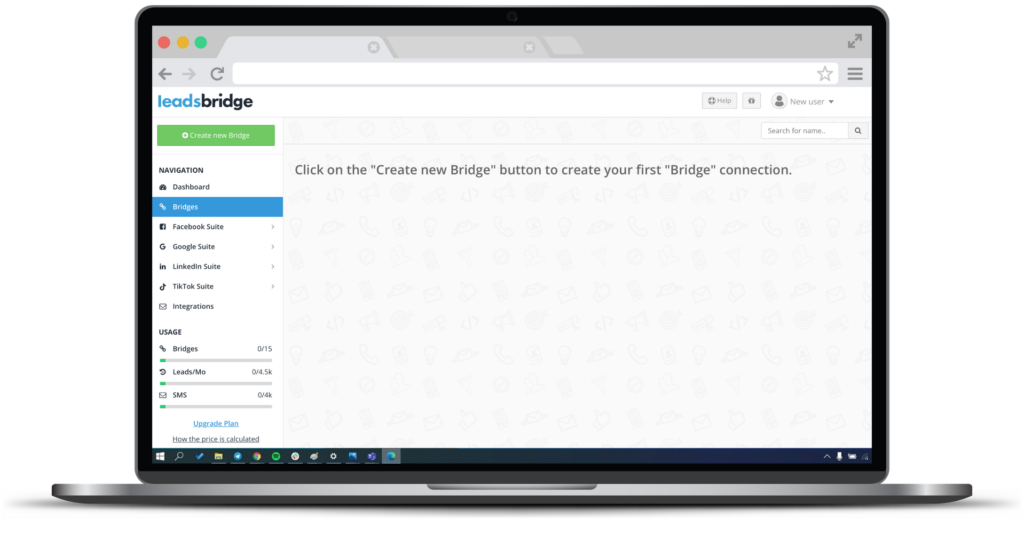
Step 2: Selecting the source & destination platforms.
Find the desired Source, for example, your favorite CRM from the drop-down menu and select Facebook Conversions API as Destination. Then, click “Continue”.
Now, you can name your bridge by clicking on the edit pencil icon. This can help you easily find your bridge later.
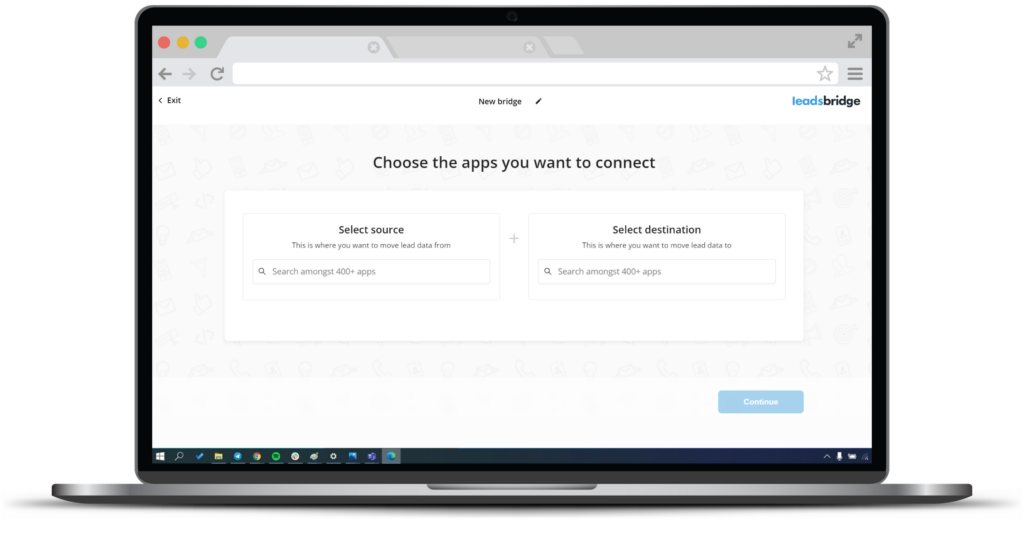
Step 3: Account authorization.
Here, you’ll need to connect your accounts by selecting your source- let’s say, Salesforce® – and your destination, Facebook Conversions API, and connect your accounts for both tools.
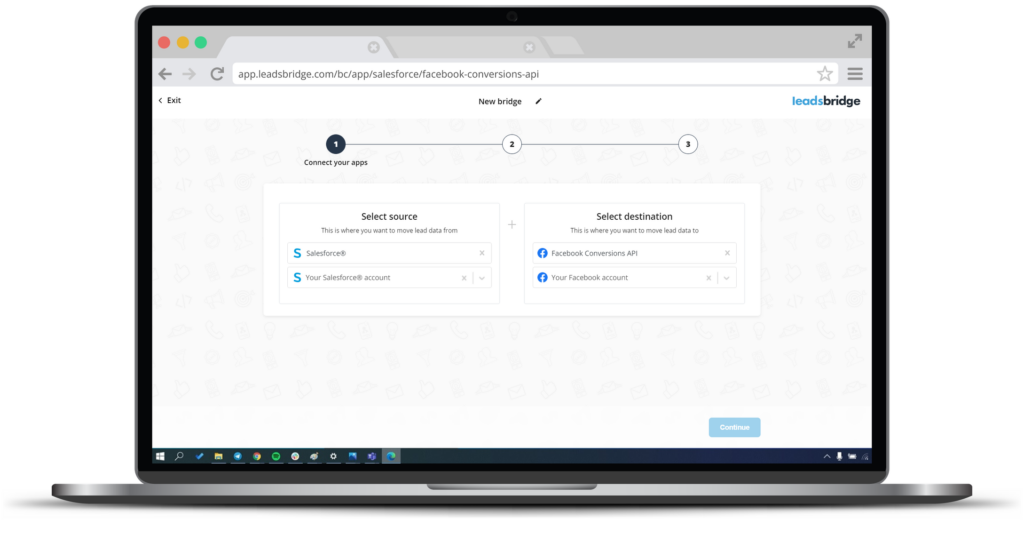
Step 4: Fields mapping.
At this point, you have to make sure that all fields of data are mapped correctly between your source and destination apps.
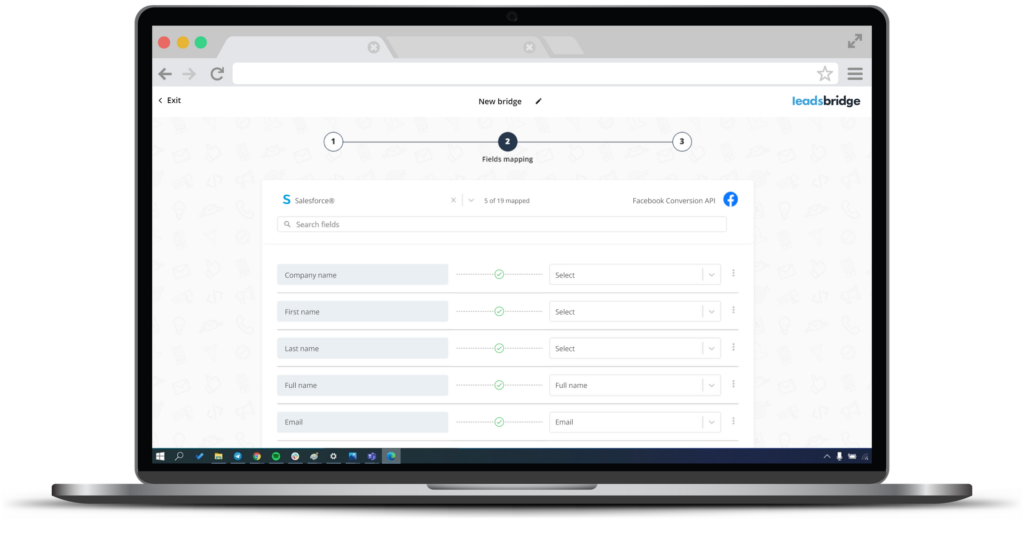
Step 5 (optional): Testing the Facebook Conversions API integration.
You have the option to test your new integration in your LeadsBridge dashboard using a mock-up lead or an existing one.
After mapping the fields and inputting the necessary information, click “Test now.” Check your inbox for an email containing the testing stage information if the integration was set up correctly.
You can choose to do this during or even after creating the bridge.
Step 6: Save & publish.
Once everything is matched correctly, click “Save & publish”. Your bridge will be officially completed, and you’ll see it added to your bridge dashboard.
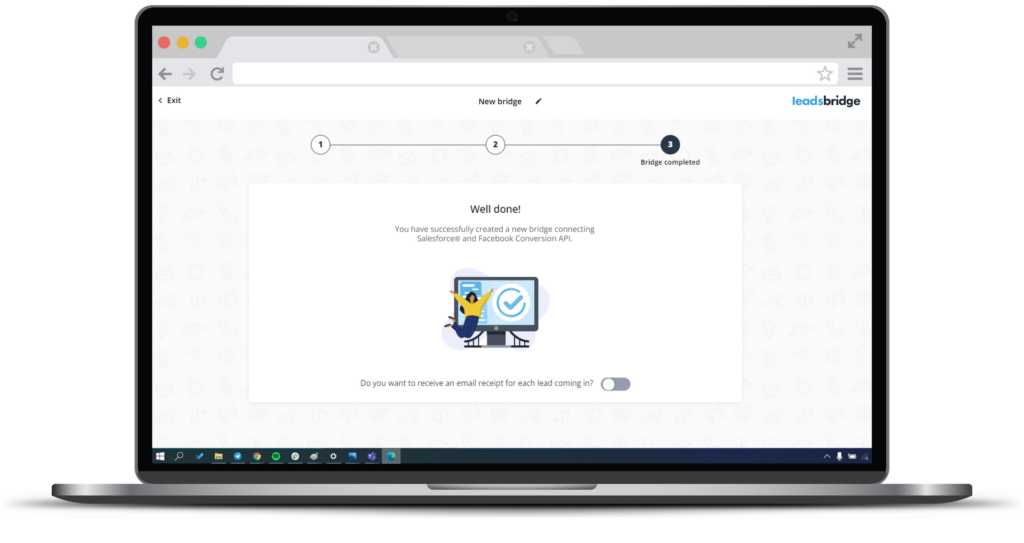
And just like that, your integration is ready to go live, and you’re ready to receive new leads!
Key takeaways
Although the loss of third-party data has posed a major obstacle, businesses are continuously adapting to the change, learning how to operate in a cookieless landscape by looking to first-party to create impactful campaigns.
Having gained a comprehensive view of Facebook Conversions API, it cannot be denied that this tool is of substantial benefit to advertisers the world over, using it to gain heightened insight into the customer’s journey and customize their ad experience to achieve better results.
Most importantly, all of this is achieved whilst maintaining data privacy regulations.












